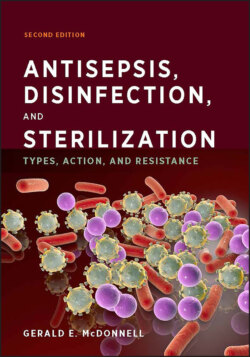Читать книгу Antisepsis, Disinfection, and Sterilization - Gerald E. McDonnell - Страница 17
1.3.2 Eukaryotes and Prokaryotes
ОглавлениеEukaryotes and prokaryotes in their basic structure consist of single discrete cells. Cells are the basic units of life for these microorganisms, as well as the building blocks for multicellular organisms—plants and animals. Eukaryotes and prokaryotes are distinguished based on their microscopic structures; prokaryotes are considered much smaller and simpler in structure, while eukaryotes are larger and more organized (Table 1.3). Eukaryotic cells include fungi, protozoa, algae, and human and plant cells. Prokaryotes include a diverse variety of eubacteria and archaea. Viruses are distinct and are considered separately, because they do not possess mechanisms for self-replication and depend on cells, in which they grow and multiply, for survival.
